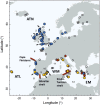A legacy of contrasting spatial genetic structure on either side of the Atlantic-Mediterranean transition zone in a marine protist
- PMID: 23213247
- PMCID: PMC3529037
- DOI: 10.1073/pnas.1214398110
A legacy of contrasting spatial genetic structure on either side of the Atlantic-Mediterranean transition zone in a marine protist
Abstract
The mechanisms that underpin the varied spatial genetic structures exhibited by free-living marine microorganisms remain controversial, with most studies emphasizing a high dispersal capability that should redistribute genetic diversity in contrast to most macroorganisms whose populations often retain a genetic signature of demographic response to historic climate fluctuations. We quantified the European phylogeographic structure of the marine flagellate Oxyrrhis marina and found a marked difference in spatial genetic structure, population demography, and genetic diversity between the northwest Atlantic and Mediterranean Sea that reflects the persistent separation of these regions as well as context-dependent population responses to contrasting environments. We found similar geographic variation in the level of genetic diversity in the sister species Oxyrrhis maritima. Because the capacity for wide dispersal is not always realized, historic genetic footprints of range expansion and contraction persist in contemporary populations of marine microbes, as they do in larger species. Indeed, the well-described genetic effects of climatic variation on macroorganisms provide clear, testable hypotheses about the processes that drive genetic divergence in marine microbes and thus about the response to future environmental change.
Conflict of interest statement
The authors declare no conflict of interest.
Figures




Similar articles
-
High genetic diversity and fine-scale spatial structure in the marine flagellate Oxyrrhis marina (Dinophyceae) uncovered by microsatellite loci.PLoS One. 2010 Dec 23;5(12):e15557. doi: 10.1371/journal.pone.0015557. PLoS One. 2010. PMID: 21203414 Free PMC article.
-
Phylogeographic and evolutionary history analyses of the warty crab Eriphia verrucosa (Decapoda, Brachyura, Eriphiidae) unveil genetic imprints of a late Pleistocene vicariant event across the Gibraltar Strait, erased by postglacial expansion and admixture among refugial lineages.BMC Evol Biol. 2019 May 17;19(1):105. doi: 10.1186/s12862-019-1423-2. BMC Evol Biol. 2019. PMID: 31101005 Free PMC article.
-
Natural or naturalized? Phylogeography suggests that the abundant sea urchin Arbacia lixula is a recent colonizer of the Mediterranean.PLoS One. 2012;7(9):e45067. doi: 10.1371/journal.pone.0045067. Epub 2012 Sep 17. PLoS One. 2012. PMID: 23028765 Free PMC article.
-
Pillars of Hercules: is the Atlantic-Mediterranean transition a phylogeographical break?Mol Ecol. 2007 Nov;16(21):4426-44. doi: 10.1111/j.1365-294X.2007.03477.x. Epub 2007 Oct 1. Mol Ecol. 2007. PMID: 17908222 Review.
-
Evaluating signatures of glacial refugia for North Atlantic benthic marine taxa.Ecology. 2008 Nov;89(11 Suppl):S108-22. doi: 10.1890/08-0257.1. Ecology. 2008. PMID: 19097488 Review.
Cited by
-
Phylogeography of Dictyota fasciola and Dictyota mediterranea (Dictyotales, Phaeophyceae): unexpected patterns on the Atlantic-Mediterranean marine transition and taxonomic implications.PeerJ. 2019 May 16;7:e6916. doi: 10.7717/peerj.6916. eCollection 2019. PeerJ. 2019. PMID: 31143543 Free PMC article.
-
Towards omics-based predictions of planktonic functional composition from environmental data.Nat Commun. 2021 Jul 16;12(1):4361. doi: 10.1038/s41467-021-24547-1. Nat Commun. 2021. PMID: 34272373 Free PMC article.
-
Biology of the Marine Heterotrophic Dinoflagellate Oxyrrhis marina: Current Status and Future Directions.Microorganisms. 2013 Oct 21;1(1):33-57. doi: 10.3390/microorganisms1010033. Microorganisms. 2013. PMID: 27694763 Free PMC article. Review.
-
Distinct biogeographical patterns in snail gastrointestinal tract bacterial communities compared with sediment and water.Microbiologyopen. 2024 Jun;13(3):e13. doi: 10.1002/mbo3.1413. Microbiologyopen. 2024. PMID: 38825966 Free PMC article.
-
Characterization of a New Trioxilin and a Sulfoquinovosyl Diacylglycerol with Anti-Inflammatory Properties from the Dinoflagellate Oxyrrhis marina.Mar Drugs. 2017 Feb 27;15(3):57. doi: 10.3390/md15030057. Mar Drugs. 2017. PMID: 28264430 Free PMC article.
References
-
- Azam F, Malfatti F. Microbial structuring of marine ecosystems. Nat Rev Microbiol. 2007;5(10):782–791. - PubMed
-
- Finlay BJ. Global dispersal of free-living microbial eukaryote species. Science. 2002;296(5570):1061–1063. - PubMed
-
- Fenchel T, Finlay B. The ubiquity of small species: Patterns of local and global diversity. Bioscience. 2004;54(8):777–784.
-
- Šlapeta J, López-García P, Moreira D. Global dispersal and ancient cryptic species in the smallest marine eukaryotes. Mol Biol Evol. 2006;23(1):23–29. - PubMed
-
- Lowe CD, Montagnes DJS, Martin LE, Watts PC. Patterns of genetic diversity in the marine heterotrophic flagellate Oxyrrhis marina (Alveolata: Dinophyceae) Protist. 2010a;161(2):212–221. - PubMed
Publication types
MeSH terms
Substances
LinkOut - more resources
Full Text Sources

